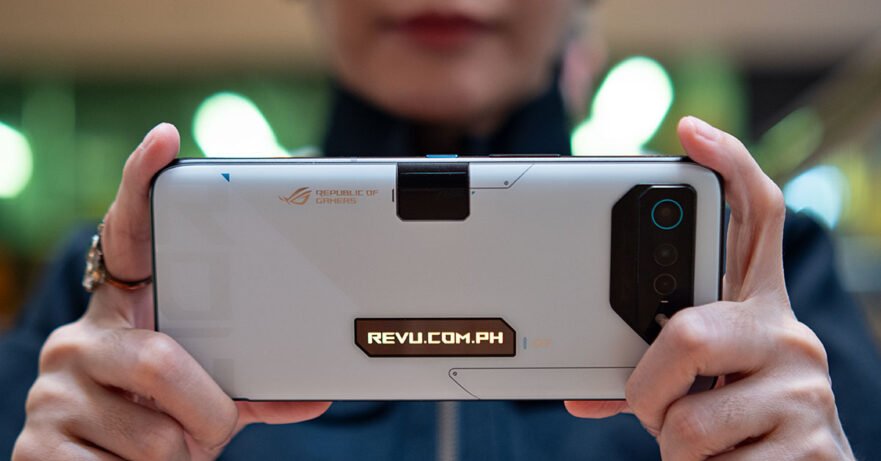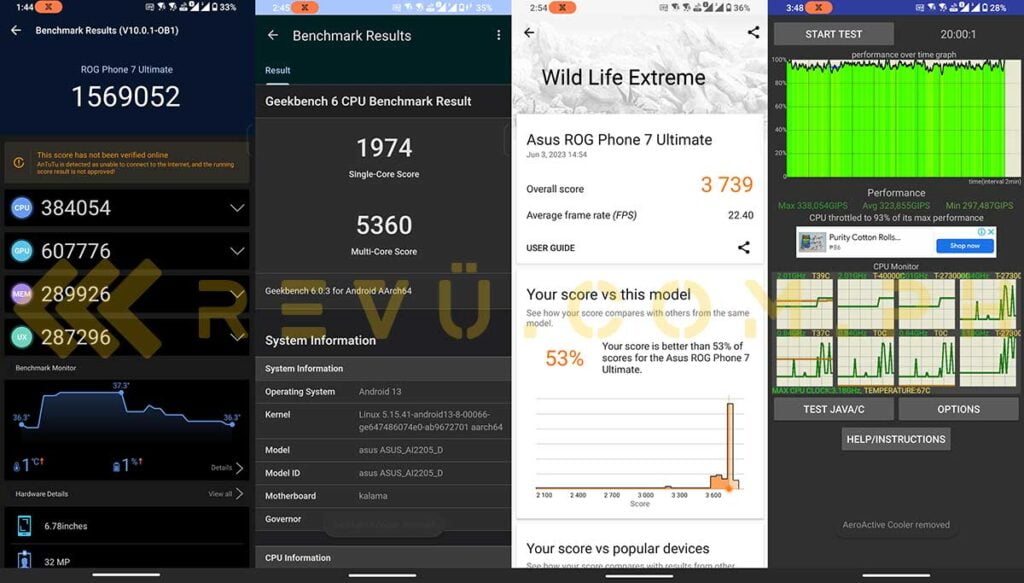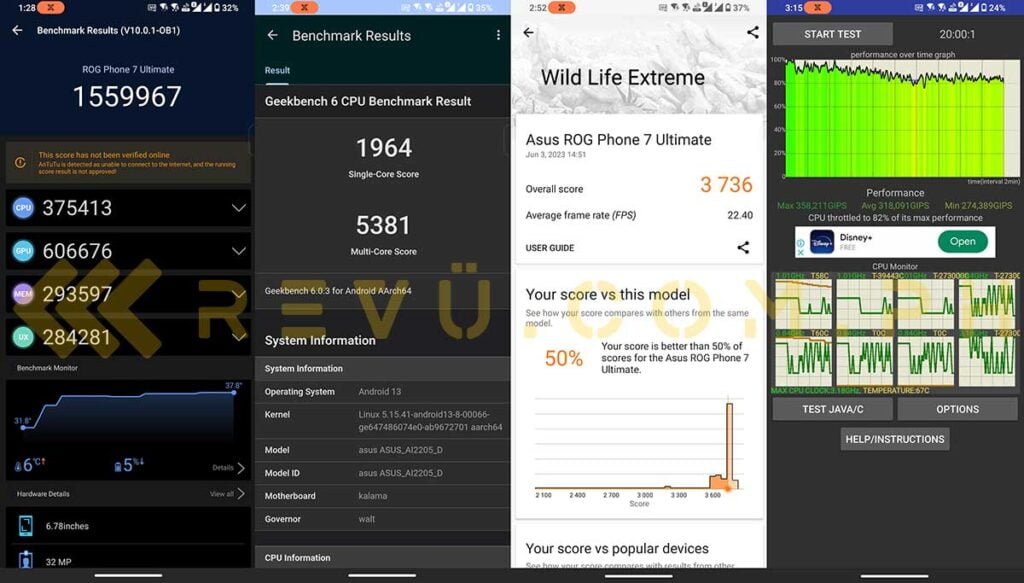ASUS has launched its latest gaming smartphone series in the Philippines, bringing two new smartphone models that promise the ultimate in performance and gamer aesthetics.
We got to test the ASUS ROG Phone 7 Ultimate for several weeks ahead of the local launch event. It has 16GB of LPDDR5X RAM and 512GB of UFS 4.0 storage, is available in the Storm White colorway exclusively on Shopee, and comes with a P69,995 ($1,255) price tag. The non-Ultimate version is more affordable, of course.
As expected, the biggest highlight of this top-of-the-line model is the performance. And ASUS doesn’t disappoint. The ROG Phone 7 Ultimate is easily the fastest Android phone we’ve reviewed so far, and the benchmarks agree. Even without the cooler, our unit scored over 1,500,000 points in the Antutu 10 public beta. We already know that the latest Qualcomm Snapdragon 8 Gen 2 chipset is a performance monster, but pairing it with the ROG Phone 7 Ultimate’s best-in-class cooling system apparently unlocks its full potential.
Short ASUS ROG Phone 7 Ultimate unboxing video
The only downside is that potential chugs down the 6,000mAh battery like it’s going out of style, so make sure to keep an external power pack connected whenever your phone runs low on charge. Outside of gaming, the ASUS ROG Phone 7 Ultimate is a marathon champ, outlasting other similarly priced flagships with a Snapdragon 8 Gen 2 chip under the hood, like the Xiaomi 13 Pro and Samsung Galaxy S23 Ultra.
In the PCMark battery-rundown test, our unit lasted 13 hours and 51 minutes with the display set to 165Hz. That translates to multi-day battery life in terms of real-world use, giving you plenty of on-screen time before you’ll need to plug in your device.
When it’s time to fill up the battery, you can do so quite rapidly with the bundled 65-watt PD charger that can charge the ROG Phone 7 Ultimate from zero to full capacity in about 50 minutes. There’s no wireless charging, which most other flagships at this price point include.
SEE ALSO: Confirmed: Both versions of ASUS ROG Ally coming to PH
No doubt, the ASUS ROG Phone 7 Ultimate is a mobile gamer’s dream. We won’t lie, though: At this point, it feels like the hardware is way ahead of the software, in that Qualcomm’s Snapdragon 8 Gen 2 isn’t a huge upgrade if you’re coming from an older Snapdragon 8 Gen processor. It won’t unlock higher framerate settings in Genshin Impact or Diablo Immortal, and your favorite Android apps won’t care that the newer chipset achieves higher benchmark numbers compared to previous releases.
Granted, upgrading your smartphone every year doesn’t make sense for most people, but gamers who are after the ultimate in performance will see diminished returns.
The ASUS ROG Phone 7 Ultimate looks and feels similar to previous releases, even sporting the same E4 AMOLED display manufactured by Samsung. The rounded corners and matte-finish back with tapered edges that flow gently into the metal frame are back, adding to the phone’s relatively comfortable form factor. The texture on the rear also contributes to the device’s great in-hand feel.
However, if you’re hoping the ROG Phone 7 series will be lighter, slimmer, and easier to use than the previous-gen ROG Phone 6, you may be disappointed. The ROG Phone 7 Ultimate, in particular, boasts similar weight and dimensions to its predecessor, coming in at 239 grams and measuring 10.3mm at its thickest point. That’s not good news considering the ROG Phone 6 Pro was one of the bulkiest smartphones we tested last year.
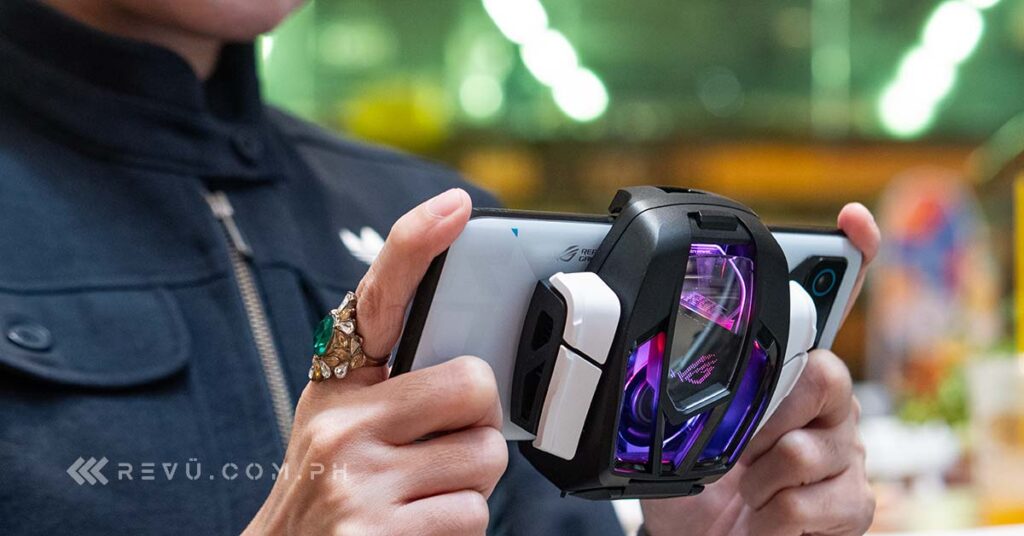
The bundled and redesigned AeroActive Cooler 7 clips on the back of the ASUS ROG Phone 7 Ultimate and cools it, allowing you to play much longer at the highest frame rates available
And that’s minus the bundled and redesigned AeroActive Cooler 7, which clips on the back of the ASUS ROG Phone 7 Ultimate and cools it, allowing you to play much longer at the highest frame rates available — if you’re fine with the extra weight and bulkiness, that is. Another thing about the new cooler attachment is that it now has a built-in subwoofer to enhance the bass performance of the handset up to 77%. You still need to connect it to a fast charger and enable Frozen mode to get the best out of it, though.
The company says that in the highest setting, the AeroActive Cooler 7 can lower the ROG Phone 7’s surface temperature by up to an impressive 25 degrees Celsius. The cool air blowing out of the two sides should likewise serve as a nice bonus for gamers with sweaty palms and fingers.
In practice, we found the accessory to be useful in bringing down the temperature of our unit during marathon gaming sessions, but it didn’t really help the smartphone achieve higher benchmark numbers, as you can see below. Switching to Frozen mode while playing The Legend of Zelda: Tears of the Kingdom on the Yuzu Nintendo Switch emulator for Android didn’t result in higher frame rates in dense environments either.
In addition to preventing your device from thermal throttling and extending your game sessions for as long as you need them to be, the AeroActive Cooler 7 features physical buttons on the back that you can bind to touch inputs in your games. This is especially useful if you like playing mobile shooters like Call of Duty: Mobile and PUBG Mobile, as it lets you assign key functions — such as reload, crouch, and alternate fire to your desired buttons — to give you a slight edge in competitive matches.
Another welcome returning feature are the AirTrigger ultrasonic sensors placed on the aluminum frame that can detect nine different gesture actions, including taps and swipes. ASUS’ Game Genie software makes mapping any game’s touchscreen controls to the shoulder buttons quick and intuitive.
You can even customize the levels of vibration for different mapping areas on the screen to help deliver a more immersive gaming experience. And like its predecessor, the ASUS ROG Phone 7 Ultimate supports gyroscopic aiming while holding an AirTrigger as well, which makes shooters easier to play without a dedicated controller or a mouse and keyboard.
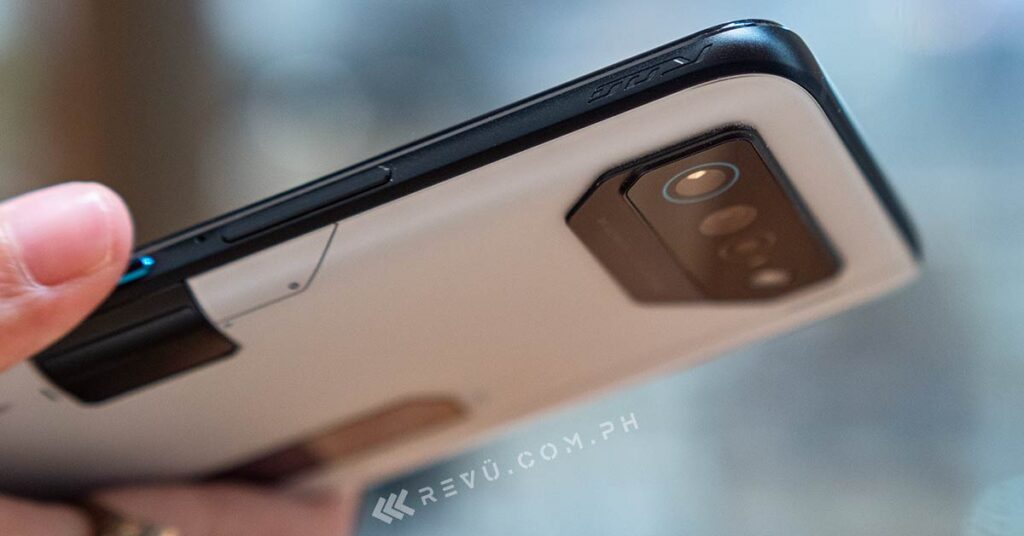
The AirTrigger ultrasonic sensors placed on the aluminum frame can detect nine different gesture actions, including taps and swipes
This time around, the ROG Phone 7 Ultimate offers a fairly clean look with a slight gaming aesthetic, thanks to its interesting yet less handy ROG Vision matrix display at the back. Similar to previous iterations, this 2-inch OLED panel can display animations when activating certain functions or personalized text. Among the available options, the charging and incoming call indicators are the most helpful.
Then there’s the one-of-a-kind AeroActive Portal cooling solution, which we first saw on the MediaTek Dimensity 9000 Plus-based ROG Phone 6D Ultimate we reviewed last year. ASUS engineered the AeroActive Portal onto the back of the device as a direct pathway to the vapor chamber and other cooling components inside. It uses a motorized hinge that automatically opens up when the AeroActive Cooler 7 is installed on the phone.
Though it is difficult to test just how much of a difference to cooling the AeroActive Portal makes, the brand has advertised impressive numbers on its end, including averaging 60 fps in Genshin Impact while recording a peak temperature of 35.7 degrees Celsius on the back cover during a 60-minute playthrough. Under similar test conditions, the Samsung Galaxy S23 Ultra and Apple iPhone 14 Pro Max averaged 52.1 fps and 52.4 fps, respectively, at much higher temperatures.
There are a couple of holdovers from last year’s release, with the most obvious one being the display. The ASUS ROG Phone 7 Ultimate packs a 6.78-inch FHD+ E4 AMOLED screen that has large bezels on the top and bottom to accommodate the front-facing stereo speakers and hits a 165Hz refresh rate, just like the ROG Phone 6 Pro and ROG Phone 6D Ultimate before it.
However, do note that most mobile games offer framerate caps of 120Hz or lower, so you won’t see the full benefit of this gaming phone’s super-fast display until you play a game with an unlimited framerate setting like Minecraft, Dead Cells, and Alto’s Odyssey.
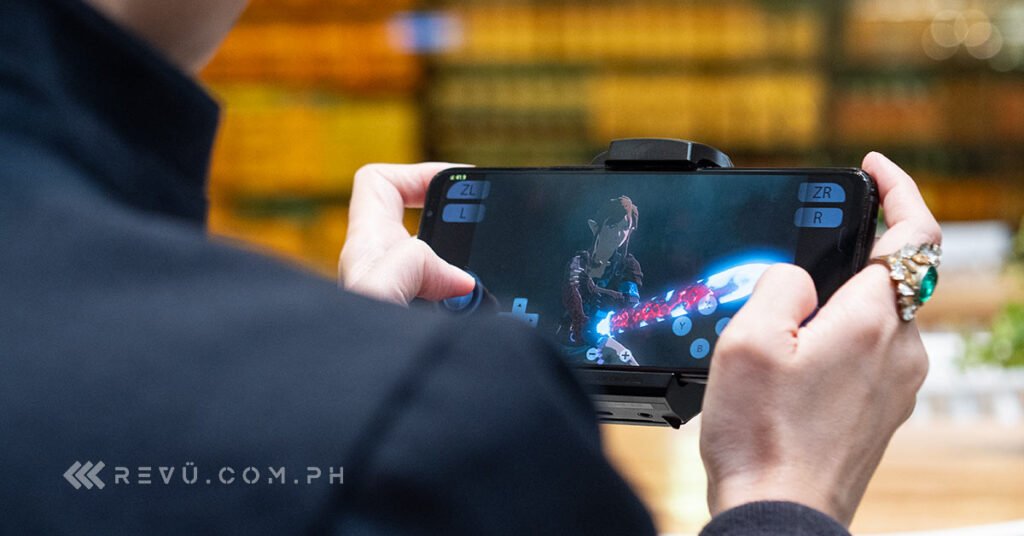
The AMOLED display is vibrant and offers a higher peak brightness of 1,500 nits, compared to 1,200 nits on the ROG Phone 6 series
The AMOLED panel is vibrant and offers a higher peak brightness of 1,500 nits, compared to 1,200 nits on the ROG Phone 6 series. It also delivers a 720Hz touch-sampling rate, meaning it can respond to your touch up to 720 times per second. This is highly useful in mobile gaming, particularly shooters, where your reaction time can mean all the difference between winning and losing. A more sensitive screen can prove to be a major advantage, as it should be able to respond to your taps and swipes without any input lag.
With everything the ASUS ROG Phone 7 Ultimate has going for it — at least, performance-wise — one could forget about the cameras on the front and back. Which checks out since the main camera setup doesn’t impress as much as the rest of the hardware. The ROG Phone 7 Ultimate features the same 50-megapixel Sony IMX766 sensor as the primary camera on the ROG Phone 6 line, and it’s accompanied by identical cameras for ultrawide and macro shots.
Yet, for some reason, we believe the previous-gen models took better photos while utilizing the same set of sensors in a variety of conditions. We certainly don’t recall seeing severe processing lag on the ROG Phone 6 units we tested. There’s a delay of two to three seconds between photos most of the time. Hopefully, this issue will be fixed in a future update; but, in the meantime, the noticeable processing lag on our device prevented us from taking a lot of pictures with it.
Sample shots
Final thoughts
The ASUS ROG Phone 7 Ultimate is, without a shadow of a doubt, the most powerful Android smartphone out there. It’s a benchmark beast and a marathon runner that lasts more than a day. Its large AMOLED display, while not super-efficient, is also among the fastest and most responsive we’ve ever laid eyes on. The improved cooler attachment is a nice touch as well, and does more than just cool the device’s internal components during lengthy gaming sessions.
The biggest letdowns here are the camera system and Android’s lack of high-quality games that can give the Qualcomm Snapdragon 8 Gen 2 chipset and ASUS’ cooling solution a run for their money.
ASUS ROG Phone 7 and ASUS ROG Phone 7 Ultimate specs
- 6.78-inch FHD+ Samsung E4 AMOLED display, 165Hz refresh rate, 720Hz touch sampling rate
- 4nm Qualcomm Snapdragon 8 Gen 2 5G chipset
- Adreno 740 GPU
- 12GB/16GB LPDDR5X RAM
- 256GB/512GB UFS 4.0 storage
- 50-megapixel main, 13-megapixel ultrawide, and macro cameras
- 32-megapixel front camera
- Under-display fingerprint reader
- 6,000mAh battery
- 65-watt wired charging
- 3.5mm audio port
- AeroActive Portal cooling system (Ultimate version only)
- 2-inch ROG Vision rear OLED (Ultimate version only)
- AirTriggers
- Stereo speakers with amplifiers
- IP54 splash resistance
- Android 13 with ROG Armoury Crate
- Color: Phantom Black, Storm White
Share this Post


